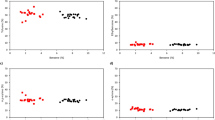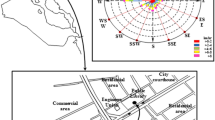Abstract
Exposure to benzene has been associated with multiple severe impacts on health. This notwithstanding, at most monitoring stations, benzene is not monitored on a regular basis. Data were used from two different monitoring stations located on the eastern Mediterranean coast: (1) a traffic monitoring station in Tel Aviv located in an urban region with heavy traffic and (2) a general air quality monitoring station in Haifa Bay located in Israel’s main industrial region. At each station, hourly, daily, monthly, seasonal, and annual data of benzene, NO x , mean temperature, relative humidity, inversion level, and temperature gradient were analyzed over 3 years: 2008, 2009, and 2010. A prediction model for benzene rates based on NO x levels (which are monitored regularly) was developed to contribute to a better estimation of benzene. The severity of benzene pollution was found to be considerably higher at the traffic monitoring station than at the general air quality station, despite the location of the latter in an industrial area. Hourly, daily, monthly, seasonal, and annual patterns have been shown to coincide with anthropogenic activities (traffic), the day of the week, and atmospheric conditions. A strong correlation between NO x and benzene allowed the development of a prediction model for benzene rates based on NO x , the day of the week, and the month. The model succeeded in predicting the benzene values throughout the year. The prediction model suggested in this study might be useful for identifying potential risk of benzene in other urban environments.






Similar content being viewed by others
References
Alpert, P., Osetinsky, I., Ziv, B., & Shafir, H. (2004). Semi-objective classification for daily synoptic systems: application to the eastern Mediterranean climate change. International Journal of Climatology, 24, 1001–1011.
ASTDR (Agency for Toxic Substances and Disease Registry). (2011). Toxic substances portal: benzene. Agency for Toxic Substances and Disease Registry, Atlanta. http://www.atsdr.cdc.gov/substances/toxsubstance.asp?toxid014.
Atkinson, R. (2000). Atmospheric chemistry of VOCs and NOx. Atmospheric Environment, 34, 2063–2101.
Avogbe, P. H., Ayi-Fanou, L., Cachon, B., Chabi, N., Debende, A., Dewaele, D., Aissi, F., Cazier, F., & Sanni, A. (2011). Hematological changes among Beninese motor-bike taxi drivers exposed to benzene by urban air pollution. African Journal of Environmental Science and Technology, 5(7), 464–472.
Bono, R., Scursatone, E., Schilirò, T., & Gilli, G. (2003). Ambient air levels and occupational exposure to benzene, toluene, and xylenes in Northwestern Italy. Journal of Toxicology and Environmental Health, 66(6), 519–531.
Carslaw, D. C. (2005). Evidence of an increasing NO2/NOX emissions ratio from road traffic emissions. Atmospheric Environment, 39, 4793–4802.
Christensen, J.S., & Elton, J. (1996). Soil and groundwater pollution from BTEX. Department of Civil and Environmental Engineering, Virginia Tech, Blacksburg. http://www.cee.vt.edu/ewr/environmental/teach/gwprimer/btex/btex.html.
Dayan, U., & Rodnizki, J. (1999). The temporal behavior of the atmospheric boundary layer in Israel. Journal of Applied Meteorology and Climatology, 38, 830–836.
Dayan, U., Lifshitz-Goldreich, B., & Pick, K. (2002). Spatial and structural variation of the atmospheric boundary layer during summer in Israel—profiler and rawinsonde measurements. Journal of Applied Meteorology and Climatology, 41, 447–457.
EC (Environment Canada). 2013. Weather conditions that affect air quality. http://ec.gc.ca/cas-aqhi/default.asp?lang=En&n=F3AF73F4-1
Eden, T. (2010). Aetiology of childhood leukaemia. Cancer Treatments Reviews, 36, 286–297.
EPA (U.S. Environmental Protection Agency). (2009). Benzene—TEACH Chemical Summary. http://www.epa.gov/teach/chem_summ/BENZ_summary.pdf
EU (European Union). (2000). Directive 2000/69/EC of the European Parliament and of the Council of 16 November 2000 relating to limit values for benzene and carbon monoxide in ambient air. Official Journal of the European Union, L313, 12–21.
Filella, I., & Penuelas, J. (2006). Daily, weekly, and seasonal time courses of VOC concentrations in a semi-urban area near Barcelona. Atmospheric Environment, 40, 7752–7769.
Goldreich, Y. (2003). The climate of Israel: Observation, research and application. New York: Kluwer.
Hanna, S. R., & Yang, R. (2001). Evaluations of mesoscale model predictions of near-surface winds, temperature gradients, and mixing depths. Journal of Applied Meteorology, 40, 1095–1104.
Hayes, R. B., Songnian, Y., Dosemeci, M., & Linet, M. (2001). Benzene and lymphohematopoietic malignancies in humans. American Journal of Industrial Medicine, 40, 117–126.
IARC (International Agency for Research on Cancer, Lyon). (1998). Benzene (Group 1). http://www.inchem.org/documents/iarc/suppl7/benzene.html
Jia, C. R., Batterman, S., & Godwin, C. (2008). VOCs in industrial, urban and suburban neighborhoods—part 2: factors affecting indoor and outdoor concentrations. Atmospheric Environment, 42, 2101–2126.
Kajihara, H., Ishizuka, S., Fushimi, A., Masuda, A., & Nakanishi, J. (2000). Population risk assessment of ambient benzene and evaluation of benzene regulation in gasoline in Japan. Environmental Engineering and Policy, 2, 1–9.
Khalade, A., Jaakkola, M. S., Pukkala, E., & Jaakkola, J. J. K. (2010). Exposure to benzene at work and the risk of leukemia: a systematic review and meta analysis. Environmental Health, 9, 31.
Khoder, M. I. (2007). Ambient levels of volatile organic compounds in the atmosphere of Greater Cairo. Atmospheric Environment, 41, 554–566.
Krol, S., Zabiegala, B., & Namiesnik, J. (2012). Measurement of benzene concentration in urban air using passive sampling. Analytical and Bioanalytical Chemistry, 403, 1067–1082.
Lan, Q., Zhang, L., Li, G., Vermeulen, R., Weinberg, R. S., Dosemeci, M., Rappaport, S. M., Shen, M., Alter, B. P., Wu, Y., Kopp, W., Waidyanatha, S., Rabkin, C., Guo, W., Chanock, S., Hayes, R. B., Linet, M., Kim, S., Yin, S., Rothman, N., & Smith, M. T. (2004). Hematotoxicity in workers exposed to low levels of benzene. Science, 306, 1774–1776.
Legates, D. R., & McCabe, G. J. (2012). A refined index of model performance: a rejoinder. International Journal of Climatology, 33, 1053–1056.
McHale, C. M., Zhang, L., & Smith, M. T. (2012). Current understanding of the mechanism of benzene-induced leukemia in humans: implications for risk assessment. Carcinogenesis, 33, 240–252.
Modig, L., Sunesson, A.-L., Levin, J., Sundgren, M., Hagenbjörk-Gusafsson, A., & Forsberg, B. (2004). Can NO2 be used to indicate ambient and personal levels of benzene and 1, 3-butadiene in air? Journal of Environmental Monitoring, 6, 957–962.
Paz, S., Linn, S., Portnov, B. A., Lazimi, A., Futerman, B., & Barchana, M. (2009). Non-Hodgkin lymphoma (NHL) linkage with residence near heavy roads—a case study from Haifa Bay, Israel. Health & Place, 15(2), 636–641.
Qu, Q., Shore, R., Li, G., Jin, X., Chi Chen, L., Cohen, B., Melikian, A. A., Eastmond, D., Rappaport, S. M., & Yin, S. (2002). Hematological changes among Chinese workers with a broad range of benzene exposures. American Journal of Industrial Medicine, 42, 275–285.
Saaroni, H., Ziv, B., & Uman, T. (2010). Does a synoptic classification indicate the NOx pollution potential? The case of the metropolitan area of Tel Aviv, Israel. Water, Air, & Soil Pollution, 207(1–4), 139–155.
Seter, A., & Lunka, A. (1999). Synoptic conditions and their influence on dispersion of pollutions from high and low sources. In: Air quality monitoring in Israel, yearly summary for 1998. Jerusalem: Israel Ministry of the Environment, pp. 29–41 (Hebrew).
Smith, M. T. (2010). Advances in understanding benzene health effects and susceptibility. Annual Review of Public Health, 31, 133–48.
Somigliana, A., & Lerda, D. (2013). Outdoor radon and traffic load levels as cumulative indicators of PM10 and benzene air pollution. Journal of the Air & Waste Management, 63(8), 971–976.
Srivastava, A., Sengupta, B., & Dutta, S. A. (2005). Source apportionment of ambient VOCs in Delhi city. Science the Total Environment, 343, 207–220.
Steinmaus, C., Smith, A. H., Jones, R. M., & Smith, M. T. (2008). Meta-analysis of benzene exposure and non-Hodgkin lymphoma: biases could mask an important association. Occupational and Environmental Medicine, 65, 371–378.
Toll, I., & Baldasano, J. M. (2000). Modeling of photochemical air pollution in the Barcelona area with highly disaggregated anthropogenic and biogenic emissions. Atmospheric Environment, 34, 3069–3084.
U.S. Department of Health and Human Services, Public Health Service, Agency for Toxic Substances and Disease Registry. (2007). Toxicological profile for benzene. http://www.atsdr.cdc.gov/toxprofiles/tp3.pdf
Verma, D. K., & Tombe, K. D. (2002). Benzene in gasoline and crude oil: occupational and environmental implications. American Industrial Hygiene Association, 63, 225–230.
Warneke, C., de Gouw, J. A., Goldan, P. D., Kuster, W. C., Williams, E. J., Lerner, B. M., Jakoubek, R., Brown, S. S., Stark, H., Aldener, M., Ravishankara, A. R., Roberts, J. M., Marchewka, M., Bertman, S., Sueper, D. T., McKeen, S. A., Meagher, J. F., & Fehsenfeld, F. C. (2004). Comparison of daytime and nighttime oxidation of biogenic and anthropogenic VOCs along the New England coast in summer during New England Air Quality Study 2002. Journal of Geophysical Research, 109, D1309.
Weisel, C. P. (2010). Benzene exposure: an overview of monitoring methods and their findings. Chemico-Biological Interactions, 184, 58–66.
WHO (World Health Organization). (2010). WHO Guidelines for Indoor Air Quality: selected pollutants—benzene. http://www.ncbi.nlm.nih.gov/books/NBK138708/
Willmott, C. J., Robeson, S. M., & Matsuura, K. (2011). A refined index of model performance. International Journal of Climatology, 32, 2088–2094.
Wong, O., Harris, F., Armstrong, T. W., & Hua, F. (2010). A hospital-based case-control study of acute myeloid leukemia in Shanghai: analysis of environmental and occupational risk factors by subtypes of the WHO classification. Chemico-Biological Interactions, 184(1-2), 112–128.
Yang, K. L., Ting, C. C., Wang, J. L., Wingente, R. O. W., & Chan, C. C. (2005). Diurnal and seasonal cycles of ozone precursors observed from continuous measurement at an urban site in Taiwan. Atmospheric Environment, 39, 2829–2838.
Zhang, L., Guan, Y., Leaderer, B. P., & Holford, T. R. (2013). Estimating daily nitrogen dioxide level: exploring traffic effects. Annals of Applies Statistics, 7, 1763–1777.
Author information
Authors and Affiliations
Corresponding author
Rights and permissions
About this article
Cite this article
Paz, S., Goldstein, P., Kordova-Biezuner, L. et al. Differences in Benzene Patterns Among Traffic and Industrial Areas and a Prediction Model for Benzene Rates Based on NO x Values. Water Air Soil Pollut 226, 161 (2015). https://doi.org/10.1007/s11270-015-2406-6
Received:
Accepted:
Published:
DOI: https://doi.org/10.1007/s11270-015-2406-6




